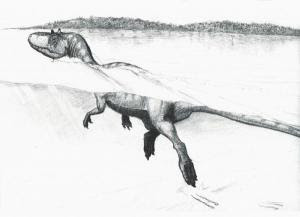 Ancient footprints have provided compelling evidence that some dinosaurs were able to swim. The 15m (50ft) trackway was discovered in the Cameros Basin in Spain, which, 125 million years ago, in the Early Cretaceous was a vast lake.
Ancient footprints have provided compelling evidence that some dinosaurs were able to swim. The 15m (50ft) trackway was discovered in the Cameros Basin in Spain, which, 125 million years ago, in the Early Cretaceous was a vast lake.
The unusual-shaped prints suggest the animal clawed at sediment on the lake bottom as it swam in about 3m (10ft) of water. Though it has been suggested that large sauropods occasionally waded through shallow waters, it is thought that these tracks were left by a large, bipedal, carnivorous dinosaur that was not wading, but rather was using the water to support its body.
Dr Loic Costeur, a palaeontologist at the University of Nantes, France, says "The Cameros Basin has thousands of walking footprints from diverse dinosaur fauna, but when we saw these it was obvious straightaway that this was a swimming dinosaur."
The underwater trackway is well-preserved in sandstone and is made up of 12 consecutive prints each consisting of two to three scratch marks. Ripple marks around the track suggest the dinosaur was swimming against a current, attempting to keep a straight path. Dr Costeur also stated that "The dinosaur swam with alternating movements of the two hind limbs: a pelvic paddle swimming motion."
I guess it was a sort of a prehistoric doggie paddle:)





Comments